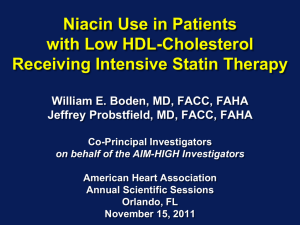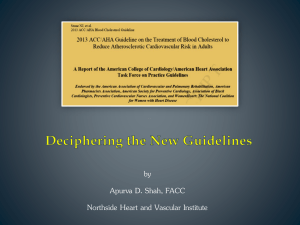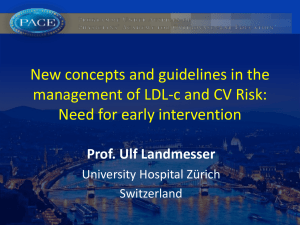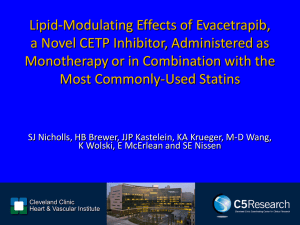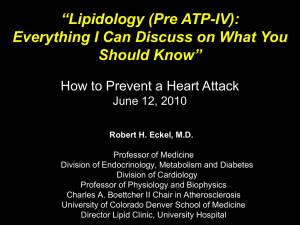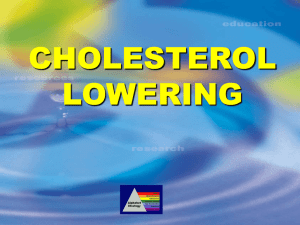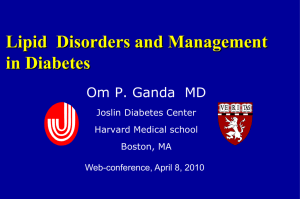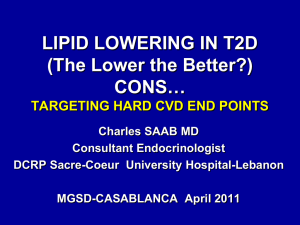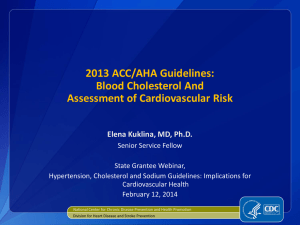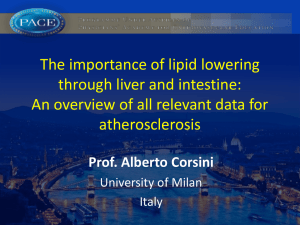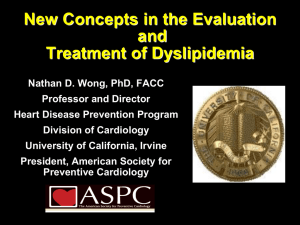Lipid Management in 2013 by Dr. Orringer
advertisement
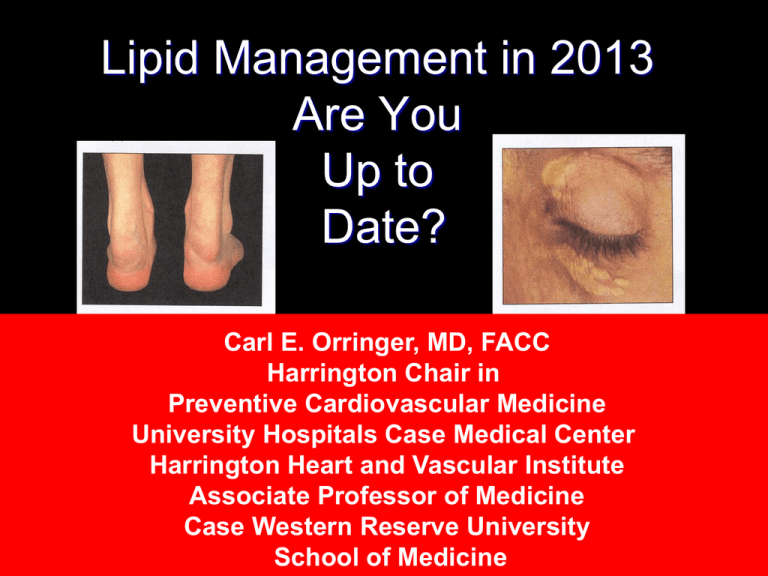
Lipid Management in 2013 Are You Up to Date? October 30, 2007 Carl E. Orringer, MD, FACC Harrington Chair in Preventive Cardiovascular Medicine University Hospitals Case Medical Center Harrington Heart and Vascular Institute Associate Professor of Medicine Case Western Reserve University School of Medicine University Hospitals Heart & Vascular Institute How Increased Concentration of Apo B Containing Particles Promotes Atherosclerosis ApoB lipoprotein particles Blood Monocytes bind to adhesion molecules Smooth muscle Inflammatory response Modification Macrophage Foam cell ApoB = apolipoprotein B. 1. Tabas I et al. Circulation. 2007;116:1832–1844. 2. Williams KJ et al. Arterioscler Thromb Vasc Biol. 1995;15:551–561. 3. Williams KJ et al. Arterioscler Thromb Vasc Biol. 2005;25:1536–1540. 4. Steinberg D et al. N Engl J Med. 1989;320:915–924. Atherothrombotic Vascular Disease: Response-to-Retention Model1 Plaque rupture Thinning fibrous cap • Fibrous cap thinning • Plaque rupture and thrombosis • Atherothrombotic vascular disease (eg, MI and stroke) MI = myocardial infarction. 1. Tabas I et al. Circulation. 2007;116:1832–1844. Atherosclerosis Progression1–3 Normal Artery Fatty streak involving lipoprotein and immune cell infiltration 1. Tabas I et al. Circulation. 2007;116:1832–1844. 2. Hansson GK. N Engl J Med. 2005;352:1685–1695. 3. Jawad E et al. Dis Mon. 2008;54:671–689. Plaque rupture and thrombosis (acute coronary event) Gradual outward expansion of arterial wall Inward expansion causing luminal narrowing (chronic stable angina) Lipoprotein Physiology Made Simple GI Tract Food is consumed 1 Adipose tissue Food is absorbed and converted to transporter particles 3 2 Transporter 3 particles Liver 4 Disassembles transporter particles to prevent clogged transport pathways Assembles key body maintenance particles, substrates for hormone assembly 5 5 GI Tract Refuse eliminated from the body 8 7 Liver Accepts refuse from plasma Plasma Energy storage (starvation) Muscle Energy utilization Cell membranes, Salt and H2O balance Reproductive hormones Vitamins 6 Particles provided that eliminate the refuse Duodenal/ Jejunal enterocyte Intestinal lumen Glycerol Phytosterols Cholesterol Fatty acids Bile acids Phospholipids Plasma Lymphatics A1 B-48 Glucose Glycerol A2 A4 CM C (trace) E (trace) Lipoprotein lipase Phospholipids Triglycerides C E Micelles Fatty acids MTP NPC1L1 A4 Phospholipids B-48 CM CM Cholesterol ACAT ABCG5 ABCG8 FC CE Free fatty acids To HDL Chylomicron (CM) Apo B-48 Cholesterol Surface Components Adipose Tissue CMR Muscle CM remnant HDL Apo E Acetate B-48 Bile acids VLDL remnants E3 CMR E3 Liver Remnant receptor LDL-Related protein CM remnants degradation E LDL receptor C3 C2 VLDL B-100 Cell membranes E C3 C2 VLDL E IDL B-100 SRB1 receptor Vitamins CETP HDL A1 A2 Hormones B-100 B-100 CETP Gallbladder LDL FC Macrophage Dietary Priorities in Dyslipidemia Reduced intake of saturated fat and cholesterol Increased intake of soluble fiber and plant sterols/stanols In overweight and obese patients, reduced caloric intake to achieve weight reduction In hypertriglyceridemic patients, same as above plus reduced intake of simple carbohydrates Greatest impact of diet tends to be in overweight or obese patients with atherogenic dyslipidemia Adding Soluble Fiber to the Diet Whole grains Nuts and seeds Fruit Legumes Adding Plant Sterols and Stanols to the Diet Goal is 2000-2500 mg daily Dietary options containing these functional foods Margarines OJ Milk and non-dairy drinks Breads Mechanism of Action of Plant Sterols/Stanols and Fiber Intestinal Lumen Glycerol Phytosterols Cholesterol Fatty acids Phospholipids Micelles Duodenum and Jejunal Enterocyte Glycerol + 3 FA Soluble fiber Plant sterols and stanols Triglycerides Bile acids Mixed Micelles Microsomal triglyceride transfer protein Chylomicron NPC1L1 Cholesterol Phopsho;ipids Apo B-48 LDL-C Lowering Drug Therapy Match Drug with Site of Action Statins Ezetimibe Resins High-dose niacin Lomitapide Mipomersin Microsomal triglyceride transport protein Intestinal bile acid transporter NPC1L1 Adipose tissue Apo B HMGCoA Reductase LDL-C Lowering Drugs: Mechanisms of Action Small intestine Proximal Acetyl CoA NPC1L1 Micelles Ezetimibe Distal Bile Liver Intestinal Bile Acid Transporter HMG CoA reductase Statin Cholesterol FFA Apo C1,2,3 Tg Apo E Apo B Lomitapide Mipo VLDL Niacin FFA CE VLDL Adipose Tissue RLP Resins IDL LDL What’s New in Lipids in 2013 NCEP ATP 3 transitions to NCEP ATP4 Update on dietary and drug therapy for lipid disorders Increased emphasis on the metabolic syndrome Questions about role of niacin in treatment of atherosclerotic vascular disease New approaches to LDL-C lowering and HDL-C raising therapy NCEP ATP III Approach to Primary Prevention of CHD Count traditional risk factors: cigarette smoking; HBP or on Rx for HBP; HDL-C <40 mg/dl; family Hx premature CHD in 1st degree relatives (♂<55, ♀<65); age (males ≥45, females ≥55) Use Framingham risk scoring to estimate CHD risk for those with 2 or more risk factors Manage lipids based upon the principle of matching treatment intensity to estimated risk Expert Panel, ATP III. Circulation 2002;106:3143-3421 NCEP/Framingham risk scores: Estimate of 10-yr Hard CHD risk in men without CHD Age (y) Points 20–34 –9 35–39 –4 40–44 0 45–49 3 50–54 6 55–59 60–64 8 10 Total-C (mg/dL) 20–39 40–49 Points Age (y) 50–59 <160 160–199 200–239 240–279 ? 280 0 4 7 9 11 0 3 5 6 8 0 2 3 4 5 Age (y) 20–39 40–49 50–59 60–69 70–79 0 8 0 5 0 3 0 1 0 1 Nonsmoker Smoker Point total: <0 10-yr risk (%) <1 0 1 1 2 1 1 3 1 4 1 65–69 70–74 75–79 11 12 13 HDL-C (mg/dL) 5 2 60–69 70–79 0 1 1 2 3 0 0 0 1 1 6 2 7 8 3 4 Points –1 0 1 2 ? 60 50–59 40–49 <40 Systolic BP Points (mm Hg) Untreated Treated <120 120–129 130–139 140–159 ? 160 9 10 11 12 5 6 8 10 0 0 1 1 2 0 1 2 2 3 13 14 15 16 >17 12 16 20 25 ? 30 Reilly MP, Rader DJ. Circulation. 2003;108:1546-51. VBWG ATP III Update 2004: LDL-C Goals and Cutpoints for Therapy in Different Risk Categories Risk Category LDL-C Goal Initiate TLC Consider Drug Therapy Very High risk: ACS, or CHD w/ DM,multiple CRF <70 mg/dL 70 mg/dL > 70 mg/dL High risk: CHD or CHD risk equivalents (10-year risk >20%) If LDL <100 mg/dl <100 mg/dL (optional goal: <70 mg/dL) Goal <70 mg/dl 100 mg/dL > 100 mg/dL (<100 mg/dL: consider drug Rx) Moderately high risk: 2+ risk factors (10-year risk 10% to 20%) <100 mg/dL 130 mg/dL > 130 mg/dL (100-129 mg/dL: consider drug Rx) Moderate risk: 2+ risk factors ( risk <10%) <130 mg/dL 130 mg/dL > 160 mg/dL Lower risk: 0-1 risk factor <160 mg/dL 160 mg/dL >190 mg/dL Grundy S, et al. Circulation 2004;110:227 Step 1: NHLBI Critical Review of the Literature 1. What is the evidence that treatment to specific LDL-C and non-HDL-C goals reduces outcomes in atherosclerotic cardiovascular disease in primary and secondary prevention? 2. What is the evidence for efficacy and safety of statins, resins, fibrates, cholesterol absorption inhibitors and niacin? Step 2: Collaboration of Experts to Translate Literature Review into Guidelines American College of Cardiology Foundation American Heart Association National Lipid Association Evidence-Based Reviews Statin therapy reduces relative risk of CHD events in all groups, regardless of Framingham Risk score High-dose statin is more beneficial than low or moderate dose statin therapy Statin therapy is unassociated with increased risk of cancer Statin therapy is the most effective means of risk reduction in diabetic patients Restrictions on Simvastatin 80 mg Use 80 mg daily dose only in those who have been on that dose for ≥ 12 months and have not experienced toxicity Do not start new patients on 80 mg daily Treat patients who require >40 mg with an alternate lipid-altering therapy Switch patients who need to be started on a drug interacting with simvastatin to an alternate statin www.fda.org 6/8/11 Simvastatin Dosing Regulations Contraindicated: itraconazole, ketoconazole, posconazole, erythromycin, telithromycin, HIV protease inhibitors, nefazodone, gemfibrozil, cyclosporine and danazol Do not exceed 10 mg daily: diltiazem, verapamil Do not exceed 20 mg daily: amlodipine, ranolazine, amiodarone www.fda.gov 6/8/11, 12/15/11 Hepatic Function Testing in Patients Receiving Statins Traditionally ALT and AST have been routinely measured during statin maintenance therapy Irreversible hepatic damage due to statins is extremely rare and likely idiosyncratic (less than 2 per one million patient-years) There are no data to support routine LFT monitoring to identify such patients FDA therefore recommends only baseline hepatic function studies and follow-up testing as clinically warranted; routine LFT monitoring is no longer recommended. www.fda.gov 2/28/12 Cognitive Adverse Effects of Statins Occasional patients over age 50 experience notable, but ill-defined memory impairment that resolves upon discontinuation of statin therapy Such memory impairment may occur at any time during statin therapy There is no association between statin therapy and Alzheimer’s dementia There is no association between memory loss and specific statin, dose, patient’s age or any specific drugdrug interaction Consider withdrawing the drug and using alternate therapies when new memory loss is clinically evident www.fda.gov 2/28/12 Changes in Blood Glucose in Patients Receiving Statins JUPITER reported an increased incidence of investigator reported diabetes in the rosuvastatin treated patients A meta analysis of 13 statin trials reported a 9% increased risk of incident diabetes Statin labels have now been revised to reflect that statin therapy may be associated with a rise in HgbA1C and fasting plasma glucose Consensus is that benefits of statin therapy in appropirate patients far outweighs DM risk www.fda.gov 2/28/12 The Metabolic Syndrome and Non-HDL Cholesterol The Metabolic Syndrome Requires 3 or more Waist circumference >35”♀ or 40”♂ Fasting glucose 100-125 mg/dl BP ≥130/85 or on anti-HBP meds HDL-C < 50 mg/dl♀ or <40 mg/dl ♂ Triglycerides ≥ 150 mg/dl Increased risk for type 2 DM and CHD LDL-C is not a good CHD risk predictor in these patients The Metabolic Syndrome A Growing Cardiometabolic Phenotype in the U.S. 1994 – 2002 2003 – 2010 ∆ (%) MetS 23.7% 34.0% +10.3 High TG 27.0% 33.0% High TG and low HDL-C 2.1% 4.8% Type II diabetes mellitus 7.9% 10.7% +6.0 +2.7 +2.8 Impaired fasting glucose 6.1% 25.9% +19.8 Obesity 19.8% 33.7% +13.9 Ramjee V, et al. J Am Coll Cardiol. 2011;58:457-463. The Heterogeneity of Lipoprotein Particles Density (g/ml) 0.95 IDL 1.006 Chylomicron Remnants 1.02 LDL 1.06 1.10 Chylomicrons VLDL HDL2 Lp(a) HDL3 n-H o N 1.20 5 s( e l c 10 20 40 DL rti a P 1 oB ap m ul c e ol ) cle i t ar p / e Non-HDL-C= cholesterol concentration in all apo B-containing particles 60 Diameter (nm) 80 1000 Understanding Non-HDL Cholesterol HDL Cholesterol + Usually Anti-atherogenic Total Cholesterol LDL Cholesterol +IDL-C +RLP-C +Lp(a)-C + VLDL Cholesterol Pro-atherogenic Non-HDL-Cholesterol Address only when Tg = 200-499 mg/dl Non-HDL-C = Total cholesterol – [HDL-C]; or [LDL-C] + [VLDL-C] Goal for non-HDL-C is <30 mg/dl above LDL-C goal because desirable Tg is <150 mg/dl When non-HDL-C is >30 mg/dl above LDL-C goal, more intensive lipid therapy is warranted Tg/5 Appears on all UH lipid profiles when triglycerides are 200-499 Treatment of the Metabolic Syndrome Treatment of choice is diet and cardiovascular exercise to achieve IBW Medical therapy is used when diet and exercise does not achieve goals Goals of lipid therapy depend upon serum triglycerides: Tg <200: Achieve LDL-C goal Tg 200-499: Achieve LDL-C goal, then non-HDL-C goal Tg ≥500: Lower Tg to <500; then achieve LDL-C goal and then non-HDL-C goal Niacin Therapy: Does it Help? Lipid Effects of Niacin Raises HDL-C Lowers triglycerides In high doses lowers LDL-C Lowers Lp(a) Earlier Studies on Niacin Reduced risk of non-fatal MI in post MI men in pre-statin era Reduced angiographic CAD progression in combination with statin therapy Reduced CIMT when used in combination with a statin AIM-HIGH: Niacin Plus Statin to Prevent Vascular Events 3414 subjects, age ≥ 45 yrs with established ASCVD (documented CHD, cerebrovascular or carotid disease or symptomatic PAD) Documented atherogenic dyslipidemia (LDL-C ≤ 160 mg/dl; HDL-C ≤ 40 mg/dl in men or ≤ 50 mg/dl in women; and triglycerides ≥ 150 mg/dl or ≤ 400 mg/dl) All patients received simvastatin to achieve LDL-C 40-80 mg/dl and if necessary, ezetimibe 10 mg daily Subjects randomized to receive Niacin E-R 2000 mg daily, or if not tolerated,1500 mg daily; or placebo Primary outcome: Composite endpoint of CHD death, nonfatal MI; ischemic stroke; hosp. for NSTE ACS; or symptomdriven coronary or cerebrovascular revascularization Study enrollment began September 2005 AIM-HIGH: Study Prematurely Terminated 5/26/11: US FDA reports early termination of trial due to lack of benefit of niacin vs. placebo when added to that achieved with simvastatin or simvastatin plus ezetimibe Small, unexplained increase in ischemic strokes in niacin arm vs. placebo (28 strokes [1.6%] versus 12 strokes [0.7%] in niacin versus placebo arms. Role that niacin played in these strokes is uncertain as 9 of the strokes in the niacin group occurred in subjects who d/c’d niacin 2 months to 4 years before their strokes HPS-2 THRIVE 25,673 pts in UK, China and Scandinavia with established atherosclerotic vascular disease All received simvastatin ± ezetimibe to lower TC to ≤ 135 mg/dl. Patients randomized to receive niacin 2g daily + laropiprant 40 mg daily and followed for major vascular events for medain follow-up of 4 years HPS-2 THRIVE Results No benefit on MVE of adding Niacinlaropiprant to aggressive LDL lowering regimen Increased incidence of serious adverse events (myopathy) in Chinese patients European Heart Journal doi:10.1093/eurheartj/eht055 Newer Drugs for LDL-C Lowering and HDL-C Raising CETP inhibitors PCSK9 inhibitors Basic HDL Metabolism Small Intestine VLDL, Remnant particles Apo A1 Phospholipids (PL) CE TG Liver FC Pre-β HDL SR-B1 Lecithin cholesteryl Acyltransferase (LCAT) LDL -R Bile CE FC Apolipoproteins PL ABC A1 transporter TG CE HDL-3 Macrophage LCAT CE ABC G1 PL transporter TG Apo B TG CE VLDL, LDL Fecal elimination CETP CE TG CE HDL-2 FC Effect of CETP Inhibition Small Intestine Apo A1 Phospholipids Liver FC Pre-β HDL SR-B1 Lecithin cholesteryl acyltransferase Apolipoproteins LDL -R FC Lipoprotein PL lipase Bile CE ABC A1 transporter CE TG HDL-3 LPL CE Macrophage LCAT ABC G1 transporter TG CETP Apo B CE TG VLDL, LDL Fecal elimination CE TG FC HDL-2 CE ↑HDL-C ↓LDL-C CETP inhibitors Torcetrapib Improved lipids, increased mortality Dalcetrapib No reduction in events post MI Anacetrapib Evacetrapib Mutations Causing Familial Hypercholesterolemia - LDL particles Apo B 4 2 1 Hepatocyte Lysosomal degradation Cholesterol 7 alpha hydroxylase LDL-R Cholesterol 5 Bile + PCSK9 + Sterol Regulatory Element Binding Protein Statin 3 1. Abnormal # or function of LDL-R 2. Defective apo B 3. PCSK9 overexpression 4. Abnormality of LDL adaptor protein (ARH) 5. Chol 7 alpha OH ase ↓ PCSK9 Inhibitors Subcutaneously administred Dosing is every 2 or every 4 weeks Reduces LDL-C by about 60-70% Has been shown to lower LDL-C in statin intolerant patients, patients with FH Ongoing trials assesing safety and efficacy in reducing CHD events
